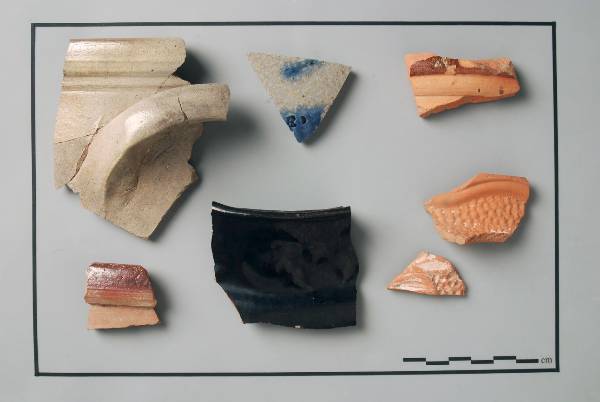The artifacts recovered from the Lower Creek Road Site represent the remains of daily life for those who occupied the site during the mid- to late 19th centuries. This section discusses the artifacts by functional group to detail patterns in household activities. The distribution of artifacts recovered from the Lower Creek Road Site follows a pattern common for domestic refuse or sheet middens. Archaeologists recovered a total of 6,654 artifacts from the excavations of the Lower Creek Road Site. Food-Related artifacts, and faunal remains represent about 26% of the site’s assemblage (n=1,747) providing information on domestic activities. Architectural materials, which may represent the construction of the house are well represented (52% of the artifact assemblage, n=3,455). Other unique and personal items are also present.
Architectural
The architectural items recovered from the Lower Creek Road Site reflect materials related to a residential structure that was built in the 19th century with later additions and improvements. Cut nails were the most prevalent (whole nails: cut=438; wire=129; and wrought=1). Wrought nails were used until the early 19th century when they were replaced by cut nails. Wire nails replaced cut nails in popularity ca. 1890. The high number of cut nails is consistent with a structure built during the 19th century. Other building materials, such as brick, were noted but not collected. Distribution of brick across the site suggested the presence of a razed chimney. The overall structure was most likely framed rather than brick or stone. Door hardware and a pipe fitting were also recovered. A high number of window glass fragments (n=1,161) is reflective of the fragility of the glass present in the structure.
Food-Related
Food-related materials consisted mostly of ceramic and glass vessels. Lab analysis identified 131 ceramic vessels and nine glass vessels in Lower Creek Road Site’s artifact assemblage. The ceramic vessels were used for activities related to the production and storage of food as well as serving food. Tablewares and teawares included creamware, pearlware, whiteware, redware, and ironstone plates, bowls, cups, and saucers used for table settings during meals and tea service. Ceramic vessels used for food production and storage included creamware, ironstone, pearlware, redware, stoneware, whiteware, and yellowware. The redware and stoneware were the most prevalent of production/storage vessels are were probably used by the Miller household due to their lack of expense. The majority of glass vessels were bottle glass possibly containing liquor, medicine, or condiments. The types of vessels recovered from the site represent an upper middle class family that attempted to keep up with the latest styles in table settings.
Non-vessel food-related items were also recovered from the site. These included seven cast iron kettle fragments and four spoons. The spoons included an iron spoon, a copper teaspoon, a decorated copper spoon, and a decorated metal spoon. The three copper spoons all have the same decoration motif suggesting that they were from the same service set.







Faunal Remains
The faunal assemblage from the Lower Creek Road site was composed primarily of food remains originating from domesticated mammal and bird. The dietary refuse was a mix of processing waste and table scraps. Pork was the most prevalent type of meat found, though chicken, beef, veal, mutton, and lamb, as well as hard-shell clam and fish, were also present. The lack of obvious butcher waste strongly suggests that animals were butchered away from the site. Whereas cattle, sheep and chicken remains were limited mainly to meat bearing elements, pig was represented by mostly skeletal elements, including the head and feet. The presence of these meat elements results from processing the head for the brain, and tongue and facial muscles for use in making processed meats. While the feet can represent a food item, they can also be processed for non-foot products. Chicken remains included feet, from a rooster, but no cranial elements. The types of faunal remains recovered indicate that chickens and pigs were raised for food at the site. However, the small number of sawed cuts beef cuts, as well as the pervasive presence of hard-shell clam, suggests that purchasing market foods was also part of the dietary habits of site residents.
Clothing
Clothing items included hose support (garter), a shoe eye, and 16 buttons. The buttons included 11 copper buttons, three iron buttons, three Prosser buttons, and one synthetic button. Most of the buttons were sized for coats or vests (ligne over 20) and the three Prosser buttons were sized for shirts or dresses (less than 20 ligne). Three of the copper buttons were sized 30 ligne suggesting that they were from the same garment. Backstamps varied for the 30 ligne buttons, which may mean they were replacements. The front decorations for these buttons were cloth and decayed away leaving only the copper base. Overall, the buttons provide evidence of clothing styles fashionable during the early to mid-19th century.

Smoking
Smoking items were limited to fragments of kaolin pipe fragments. These pipes were inexpensive and disposable, but reusable. They were the typical method of smoking during the 19th century. Excavations produced 18 fragments of kaolin pipes. A minimum number of smoking pipes could not be determined since mostly stem fragments were recovered. Decoration on the smoking pipes was limited to one pipe bowl with a fish scales motif.
Personal Items
The personal/amusement/cosmetic functional group offers some additional insight into the social identities of those who occupied the site. Toys were present among the assemblage, including three clay marbles, a porcelain doll face fragment, and a second porcelain doll fragment. Other items are associated with general household clerical activities, such as a slate pencil, an embossed milk glass Arden cosmetic bottle, harmonica reed, and bone handled pocket knife. Jewelry was represented by a decorative Bakelite comb, a clock part, a watch part, a blue glass bead, and a filigree heart pendant or locket.

